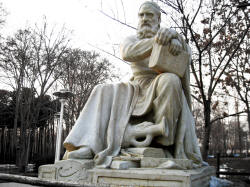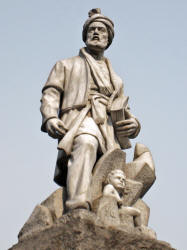ContentsSamples of Persian classical poets Samples of Persian modern poets
About Persian poetrySo strong is the Persian aptitude for versifying everyday expressions that one can encounter poetry in almost every classical work, whether from Persian literature, science, or metaphysics. In short, the ability to write in verse form was a pre-requisite for any scholar. For example, almost half of Avicenna's medical writings are in verse.
Through these courts and system of patronage emerged the epic style of poetry, with Ferdowsi's Shahnama at the apex. By glorifying the Iranian historical past in heroic and elevated verses, he and other notables such as Daqiqi and Asadi Tusi presented the "Ajam" with a source of pride and inspiration that has helped preserve a sense of identity for the Iranian peoples over the ages. Ferdowsi set a model to be followed by a host of other poets later on. The 13th century marks the ascendancy of lyric poetry with the consequent development of the Ghazal into a major verse form, as well as the rise of mystical and Sufi poetry. This style is often called "Araqi style", (western provinces of Iran were known as Araq-e Ajam or Persian Iraq) and is known by its emotional lyric qualities, rich meters, and the relative simplicity of its language. Emotional romantic poetry was not something new however, as works such as Vis o Ramin by Fakhroddin As'ad Gorgani, and Yusof o Zoleikha by Am'aq Bokharai exemplify. Poets such as Sana'i and Attar (who ostensibly have inspired Rumi), Khaqani Shirvani, Anvari, and Nezami, were highly respected Ghazal writers; however, the elite of this school are Rumi, Sa'di, and Hafez. In the didactic genre one can mention Sanai's Hadiqat-ul-Haqiqah (The Garden of Truth) as well as Nezami's Makhzan-ul-Asrār (The Treasury of Secrets). Some of Attar's works also belong to this genre as do the major works of Rumi, although some tend to classify these in the lyrical type due to their mystical and emotional qualities. In addition, some tend to group Naser Khosrow'sworks in this style as well; however, the true gem of this genre is Bustan (The Orchard) of Sa'di, a heavyweight of Persian literature. After the 15th century, the Indian style of Persian poetry (Also known as Isfahani styles) took over. This style has its roots in the Timurid era and produced the likes of Amir Khosrow Dehlavi.
The transformation brought about by Nima Youshij, who freed Persian poetry from the fetters of prosodic measures, was a turning point in a long literary tradition. It broadened the perception and thinking of the poets that came after him. Nima offered a different understanding of the principles of classical poetry. His artistry was not confined to removing the need for a fixed-length hemistich and dispensing with the tradition of rhyming but focused on a broader structure and function based on a contemporary understanding of human and social existence. His aim in renovating poetry was to commit it to a "natural identity" and to achieve a modern discipline in the mind and linguistic performance of the poet. Nima held that the formal technique dominating classical poetry interfered with its vitality, vigour and progress. Although he accepted some of its aesthetic properties and extended them in his poetry, he never ceased to widen his poetic experience by emphasising the "natural order" of this art. What Nima Youshij founded in contemporary poetry, his successor Ahmad Shamlou continued.
Parvin Etesami may be called the greatest Persian poetess writing in the classical style. One of her remarkable series, called Mast va Hoshyar (The Drunk and the Sober), won admiration from many of those involved in romantic poetry. Among the hundreds of contemporary Persian poets, notable figures of classical poetry include Mirzadeh Eshghi, Mohammad-Taghi Bahar, Aref Ghazvini, Parvin Etesami; and Nima Yushij, Ahmad Shamlou, Fereydoon Moshiri, Sohrab Sepehri, Siavash Kasrayi and Mohammad-Reza Shafiei-Kadkani maybe considered the best modern poets of Iran.
Samples of Persian classical poets... Samples of Persian modern poetsSiavash Kasrayi
|



 Few
notable classical poets have arisen since the
19th century, among whom Mohammad-Taghi
Bahar and Parvin Etesami
have been most celebrated. Mohammad-Taghi Bahar
had the title "king of poets" and had a
significant role in the emergence and
development of Persian literature as a distinct
institution in the early part of the 20th
century. The theme of his poems was the social
and political situation of Iran.
Few
notable classical poets have arisen since the
19th century, among whom Mohammad-Taghi
Bahar and Parvin Etesami
have been most celebrated. Mohammad-Taghi Bahar
had the title "king of poets" and had a
significant role in the emergence and
development of Persian literature as a distinct
institution in the early part of the 20th
century. The theme of his poems was the social
and political situation of Iran.